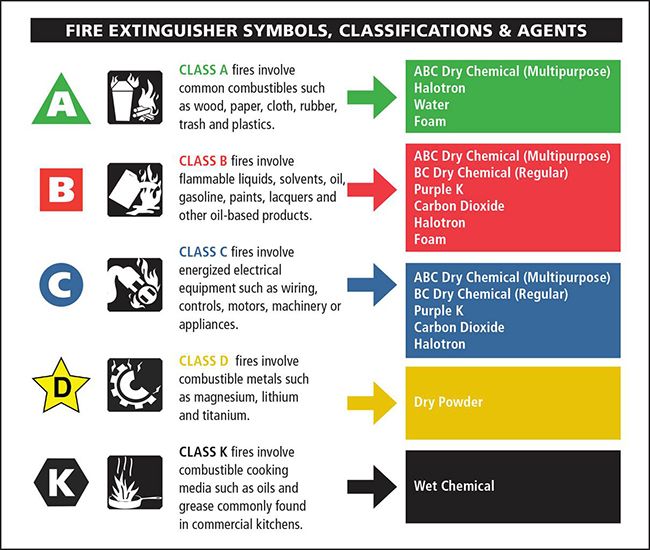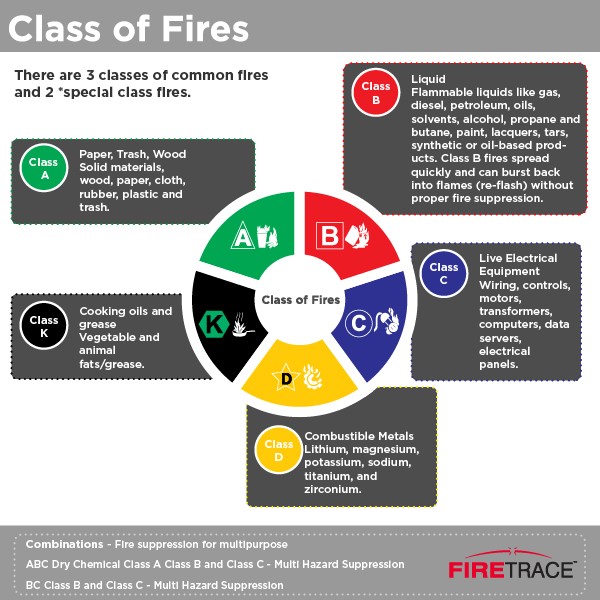Types of firearms Rifle A relatively long-barreled firearm fired from the shoulder having a series of spiral grooves cut inside the barrel a process called rifling imparting a rapid spin to a single projectile. In firefighting fires are organized into several fire classes that describe what kind of fuel or heat source it has and by extension what methods will be necessary to contain it or put it out.

Types Of Fires Kidde Fire Safety
Most of them are organized into the size class which is a system that categorizes creatures by its size.

. In fact trying to fight a blaze with the wrong method might make the situation worse. Fire Safety Video - RACE and PASS English General fire response procedures must be implemented immediately upon suspicion of a fire. In firefighting fires are organized into several fire classes that describe what kind of fuel or heat source it has and by extension what methods will be necessary to contain it or put it out 1- The United States system of classifying fires Figure 1-4 A campfire would be an example of a class.
Which extinguishers are designed for multi-purpose use and therefore are useful for Class A B or C fires. There are four classes of fires. A- Involve ordinary combustibles textiles paper wood plastics rubber.
Fires that involve flammable liquids or liquefiable solids such as petrolgasoline oil paint some waxes. The Incident Command System ICS is flexible scaling up or down as complexity and needs change. Ordinary solid combustibles such as paper wood cloth and some plastics.
Each type of fire involves different flammable materials and requires a special approach. These types are fires use commonly flammable material as their fuel source. Oxygen fuel and heat.
Due to the gaseous nature of the fuel these fires are difficult to extinguish. B- Flammable and combustible liquids and gases alcohol gasoline lubricating oils C- Electrical equipment use water mist once power supply is pulled treat as class A-B D- Combustible metals alloys magnesium potassium sodium wheels and autobody. In the event of a SUSPECTED or CONFIRMED FIRE remain calm and immediately do the following.
Similarly the Law Enforcement Incident Command System LEICS was systematized and endorsed by the Police Officers Standards and Testing organization Bartosh 2003. Class B - Fires involving flammable liquids gases oil paints or lacquer. These fires are separated into classes based on what is burning and thus what is needed to put the fire out.
Class A - Fires involving ordinary combustibles such as paper wood cloth rubber or plastics. Class A fires are defined as ordinary combustibles. Type 5 is the least complex while Type 1 is the most complex.
This is essentially the common accidental fire encountered across several different industries. Fires that involve flammable solids such as wood cloth rubber paper and some types of plastics. In firefighting fires are organized into several fire classes that describe what kind of fuel or heat source it has and by extension what methods will be necessary to contain it or put it out.
These fires are started by solid combustibles. Contents 1 Elementals 2 Dragons 3 AI Creatures 4 Ambient AI Elementals Magma Fire Elemental Glacier Ice Elemental Thunder Storm Elemental Dragons. Fires can be classified in five different ways depending on the agent that fuels them.
Playable creatures are also organized into classes a way to describe them by their traits. Class A Class B Class C Class D and Class K. They are often specific for the type of metal in question.
Find the complete series on the Fire subject site. In recent years weve also added chemical reaction as a fourth element necessary for. Fires that involve flammable gases.
Remove patients and personnel from the immediate fire area if safe to do so. Combustible Materials The first type of fire you need to be aware of is the Class A fire which is the one youll most commonly think of when you think of fire. Types of Fires and How to Extinguish Them.
Wood fabric paper trash and plastics are common sources of Class A fires. Remove Alarm Contain and Extinguish. For review in order for fire to break out three elements must be present.
This article is part of the Wildland Fire Learning In Depth series. Fire extinguishers used to fight fires are also ranked by those classes. Certain extinguishers are designed specifically for Class D or flammable metals fires.
1910155c33 Outer shell is the exterior layer of material on the fire coat and protective trousers which forms the outermost. It is designed for students who want to learn more about fire. Shotgun A shoulder-fired long gun with no rifling in.
Flammable liquids such as alcohol ether oil gasoline and grease which are best extinguished by smothering. Class C - Fires involving energized live electrical equipment such as motors appliances or power tools. Fires where the fuel is flammable or combustible gas are classified as Class C in the EuropeanAustralian system and Class B along with flammable liquids in the US system.
The US uses a different classification system to Europe and Australasia details of the differences. Multipurpose dry chemical means a dry chemical which is approved for use on Class A Class B and Class C fires. The US uses a different classification system to Europe and Australasia details of.
Heres what you need to know and how you can put these fires out safely. Electrical equipment appliances and wiring in which the use or a nonconductive extinguishing agent prevents injury from electrical shock. Municipal fire departments use IMS and the National Fire Protection Association adopted a standard NFPA 1561 on emergency services IMSs in 2000.
Trash fires are one such example.


0 Comments